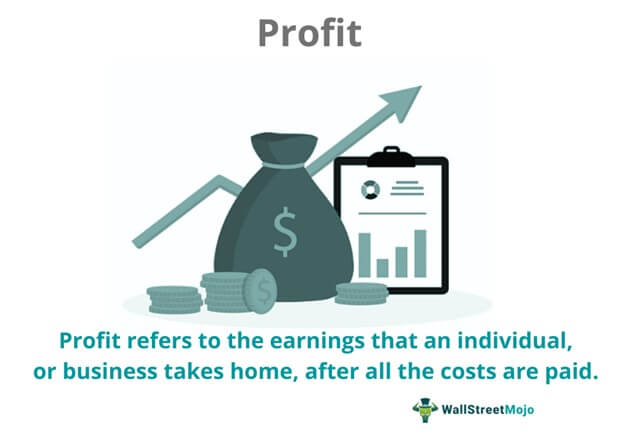Table Of Contents
Profit Meaning
Profit refers to the earnings that an individual or business takes home after all the costs are paid. In economics, the term is associated with monetary gains. The concept is fundamental to all business activities.
Businesses are evaluated based on this metric. It is further classified into three types—gross Profit, Operating Profit, and net profit. In order to divide earnings among a group of owners, concepts like profit ratio and profit-sharing are used.
Table of contents
- Profit refers to the total earnings left after settling all direct and indirect expenses.
- In everyday scenarios, the term does not always equate to financial gain or money earned; there are different kinds of profit.
- It is often considered the root cause of capitalism and free-market economies. Without monetary gains, no business can continue operations.
Profit Explained

Profit is the amount of revenue left with a business after deducting all expenses. In economics, a profitable company is the one that generates considerable revenue and still takes home a reasonable amount—after settling all the liabilities. In common parlance, though, the term does not always refer to monetary gains.
The primary goal of any business is to earn profits; without it, no company can continue business operations. When a firm makes gains monetarily, it is perceived as successful. And as a consequence, it becomes deep-rooted. Therefore, profit is called the root cause of capitalism. Capitalism is designed around monetary gains—it is a race to earn more. To achieve that, businesses come up with new ideas, marketing campaigns, and sales strategies.
When multiple partners are involved, earnings are divided among them—profit sharing plan. Business owners enter agreements to split the net income in a specific way. For example, one owner could receive a large percentage, and the other could receive a smaller share. In order to improve profit ratios, businesses try to cut costs and increase revenue.
Profit Types

#1 - Gross Profit
Also known as gross income, it is computed by subtracting the manufacturing cost of a product from total sales. Manufacturing cost is also called the cost of goods sold (COGS).
Gross income is mentioned in the company's income statement. Gross income constitutes variable cost. Fixed costs like the plant, machinery, salaries, and equipment are not included. The gross income determines business efficiency.
#2 - Operating Profit
It is generally referred to as EBIT (Earnings Before Interest and Tax). It includes both variable costs and fixed costs. Manufacturing, staff, and administration constitute primary expenses for any business.
#3 - Net Profit
It is an apt representation of how much a company takes home. It includes every cost the company incurs from start to finish and then subtracts this amount from total revenue.
In order to increase return on investment (ROI), businesses invest funds in the stock market and other financial instruments. Many companies generate excess amounts of hard cash and choose not to disclose it. Therefore, this valuation metric can be misleading.
Calculation
It is calculated by using the following formula:
Profit = Total revenue - Total expense.
Let us assume that a company manufactures bags, the total revenue for the company in the year 2021 was $1500,000, and the total expense that the company incurs for the operations is $850,000 (inclusive of fixed cost, variable cost, and miscellaneous costs for the whole year).
On applying the formula, we get:
1500,000 - 850,000 = 650,000
Thus, the bag manufacturing company will make a profit of $650,000 in 2021.
Examples
Let us look at some examples to understand the practical application of this concept:
Example #1
Richard opens a small eatery in the local market. He hires two workers—one employee cooks, the other cleans. Richard sits at the counter and manages the bills himself. He spent on rent and operating capital. The operating capital comprises raw material, cooking expenses, decoration, light, furniture, and music.
Within a month, the business made a total revenue of $4000. Within the same period, Richard clears liabilities. He covers wages for two workers, spends on operating expenses, and miscellaneous expenses. After subtracting all those expenses from the total revenue, he is left with $1200. This amount is referred to as profit.
Example #2
In April 2022, Samsung reported a 50% hike in their quarterly profits (compared to their last big earnings since 2018). The chip business accounts for half the profits.
Samsung publicly admitted that the figures were more than what they expected. Their revenue rose 18% from their 2018 hike. Yet, with the rise in inflation, the demand for smartphones, laptops, and PCs might plummet.
Frequently Asked Questions (FAQs)
It is defined as the surplus gain from a business activity or process. So, if measured in value, a person who invests $2 and makes it $5 by selling goods gains $3.
It is computed as follows:
Profit formula = total revenue - total expenses
The total expense of the whole business operations is deducted from the total revenue to determine the actual income generated by a firm.
In economics, it generally refers to money or cash generated by a business. But, in common parlance, it does not always refer to money.
Recommended Articles
This has been a guide to what is Profit & its Meaning. We discuss profit definition, business, economics, maximization, and statements using examples. You can learn more about accounting from the following articles –
